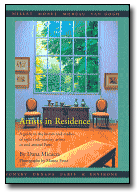Books |
Artists in Residence
Dana Micucci
By
Published: Sep 15, 2016
Category:
Non Fiction
Here, in a lovely slip case, is a slip of a book. A pamphlet, if you will. But it is packed with information to whet an art lover’s appetite — it’s an amuse bouche.
Think: hostess present. Gift for the traveler whose first stop in any new city is its museum. Or just a coffee-table dreamscape for those rare idle moments when you want to flip through a book — just not anything meaty, contemporary or depressing.
“Artists in Residence” works for all those readers, because the 19th Century was a glorious time for art in France.
Technology gets a bit of the credit. It became possible to put paint in tubes — and thus to paint out of doors at all hours.
Economics is another factor. With industrialization came the rise of a large class of owners and a growing class of managers — for the first time, there was a vibrant market for art.
Then there was media. Paris was a city of newspapers — and they wrote about the arts for a popular audience.
And, finally, there were the painters themselves. More often than not, they had large personalities and strong views. They bumped up against one another; they formed cadres, they had feuds. And they worked; their output was prodigious.
“Artists in Residence” showcases eight artists who lived in or near Paris and whose homes are now open to the public: Claude Monet, Charles-Francois Daubigny, Vincent van Gogh (okay, so the van Gogh is a cheat — the poor guy owned nothing, much less a house), Jean-Francois Millet, Rosa Bonheur, Gustave Courbet, Gustave Moreau and Eugene Delacroix. Nice that a woman is included. And that there are two houses of artists in Paris that, for all my time there, I’ve completely overlooked. [To buy “Artists in Residence” from Amazon, click here.]
The format is like a French meal: just enough. A full-page color photograph, often of a representative painting. A half-dozen photo-filled pages describing the artist’s life in his/her house. A few pages of facts: how to get there, when it’s open, what’s in the neighborhood, where to stay, where to eat.
I’m fond of art trivia, and “Artists in Residence” does not disappoint here. Monet bought Giverny for 22,000 francs. At this death, his paintings were selling for 50,000 francs. That gives you a nice perspective on the relationship between art and real estate prices — and suggests how shrewd Monet was to buy a house whose gardens would pay for themselves many times over.
Did you know that Daubigny began his career as an art restorer at the Louvre — but was fired for making “drastic alterations” to the paintings? Millet’s house was opulent, but we find him, in hard times, writing: “We have only wood for two or three days more…” Rosa Bonheur had to get special permission from the police to cross-dress and wear pants. (This law is still on the books.)
This book reminds us of the beauty of these artists’ lives as well as their art, and of the good sense of a culture that turns artists’ homes into monuments. Going to any of these houses must be like visiting a private museum. And flipping through these pages will make many readers want to take the next plane to Paris.


